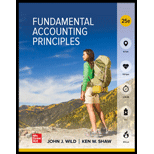
Concept Introduction:
Warranty liability:
Warranty liability implies the obligation of the seller to repair or replace a defective good supplied to a customer. The warranty expenses are accounted for in the period in which the revenue of the good is recognized as per the matching principle of accounting.
Requirement 1:
To prepare:
Concept Introduction:
Warranty liability:
Warranty liability implies the obligation of the seller to repair or replace a defective good supplied to a customer. The warranty expenses are accounted for in the period in which the revenue of the good is recognized as per the matching principle of accounting.
Requirement 2:
The warranty expenses reported for November and December
Concept Introduction:
Warranty liability:
Warranty liability implies the obligation of the seller to repair or replace a defective good supplied to a customer. The warranty expenses are accounted for in the period in which the revenue of the good is recognized as per the matching principle of accounting.
of the product. Only the plant or factory related expenses are termed as manufacturing
Requirement 3:
The warranty expenses reported for January
Warranty liability:
Warranty liability implies the obligation of the seller to repair or replace a defective good supplied to a customer. The warranty expenses are accounted for in the period in which the revenue of the good is recognized as per the matching principle of accounting.
Requirement 4:
The balance of Estimated Warranty liability on December 31
Concept Introduction:
Warranty liability:
Warranty liability implies the obligation of the seller to repair or replace a defective good supplied to a customer. The warranty expenses are accounted for in the period in which the revenue of the good is recognized as per the matching principle of accounting.
Requirement 5:
The balance of Estimated Warranty liability on January 31
Want to see the full answer?
Check out a sample textbook solution
Chapter 11 Solutions
FUND.ACCT.PRIN.(LOOSELEAF)
- Please explain the solution to this general accounting problem with accurate explanations.arrow_forwardRead The company events occured during the first half of the year and answer the following questions: 1)Determine the importance of the company having property, plant, and equipment as part of the long-term assets on its balance sheet. 2)What are the costs for determining what is included in the acquisition of property, plant, and equipment? 3)What are the methods you can use to calculate depreciation? Which method makes the most sense for this company? 4)Taking into account the disposal of property, plant, and equipment, what is the correct way to record a disposal?arrow_forwardCan you guide me through solving this financial accounting problem using proper techniques?arrow_forward
- Read The company events occured during the first half of the year and answer the following questions: 1)Determine the importance of the company having goodwill or intangibles as part of the long-term assets on its balance sheet. 2)How do companies acquire goodwill? 3)What are examples of intangible assets and how are they amortized?arrow_forwardCan you demonstrate the accurate method for solving this financial accounting question?arrow_forwardComputer Zone sells laptops. During August 2023, it sold 320 laptops at a $1,850 average price each. The August 2023 budget included sales of 350 laptops at an average price of $1,750 each. Compute the sales price variance and the sales volume variance for August 2023.arrow_forward
- The standard cost of Product ZZ includes 3 hours of direct labor at $16 per hour. The predetermined overhead rate is $28 per direct labor hour. During September, the company incurred 3,600 hours of direct labor at an average rate of $15.75 per hour and $94,200 of manufacturing overhead costs. It produced 1,200 units. Compute the total overhead variance.arrow_forwardCan you help me solve this general accounting question using valid accounting techniques?arrow_forward1) Determine the importance of the company having long-term investments as part of the long-term assets on its balance sheet. 2)Should they retain long-term investments? 3)How is the right-of-use asset determined on inception of the lease? 4)How do you calculate the amortization the cost of a leased asset? 5)Cite the applicable FASB Codification section for the following items as a list: property plant and equipment, investments, and intangibles.arrow_forward

 AccountingAccountingISBN:9781337272094Author:WARREN, Carl S., Reeve, James M., Duchac, Jonathan E.Publisher:Cengage Learning,
AccountingAccountingISBN:9781337272094Author:WARREN, Carl S., Reeve, James M., Duchac, Jonathan E.Publisher:Cengage Learning, Accounting Information SystemsAccountingISBN:9781337619202Author:Hall, James A.Publisher:Cengage Learning,
Accounting Information SystemsAccountingISBN:9781337619202Author:Hall, James A.Publisher:Cengage Learning, Horngren's Cost Accounting: A Managerial Emphasis...AccountingISBN:9780134475585Author:Srikant M. Datar, Madhav V. RajanPublisher:PEARSON
Horngren's Cost Accounting: A Managerial Emphasis...AccountingISBN:9780134475585Author:Srikant M. Datar, Madhav V. RajanPublisher:PEARSON Intermediate AccountingAccountingISBN:9781259722660Author:J. David Spiceland, Mark W. Nelson, Wayne M ThomasPublisher:McGraw-Hill Education
Intermediate AccountingAccountingISBN:9781259722660Author:J. David Spiceland, Mark W. Nelson, Wayne M ThomasPublisher:McGraw-Hill Education Financial and Managerial AccountingAccountingISBN:9781259726705Author:John J Wild, Ken W. Shaw, Barbara Chiappetta Fundamental Accounting PrinciplesPublisher:McGraw-Hill Education
Financial and Managerial AccountingAccountingISBN:9781259726705Author:John J Wild, Ken W. Shaw, Barbara Chiappetta Fundamental Accounting PrinciplesPublisher:McGraw-Hill Education





